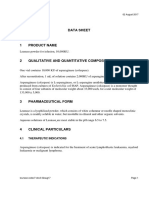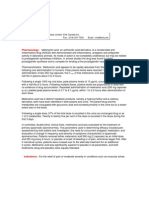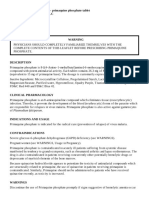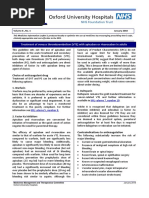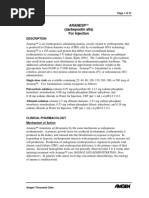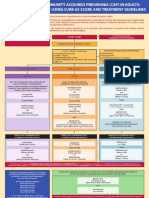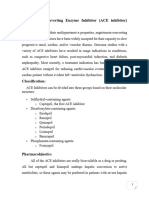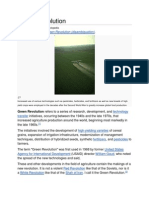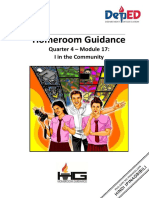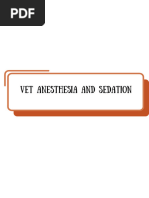MSDS Asparginase
MSDS Asparginase
Uploaded by
Clarissa AdhyatmanCopyright:
Available Formats
MSDS Asparginase
MSDS Asparginase
Uploaded by
Clarissa AdhyatmanOriginal Description:
Copyright
Available Formats
Share this document
Did you find this document useful?
Is this content inappropriate?
Copyright:
Available Formats
MSDS Asparginase
MSDS Asparginase
Uploaded by
Clarissa AdhyatmanCopyright:
Available Formats
Asparaginase
DRUG NAME:
(a) Asparaginase
(b) Erwinia asparaginase
(c) Pegaspargase
SYNONYMS:
(a) A-ase,1 ASN-ase, Colaspase, Crasnitin,2 Elspar,3 L-asparagine
1
amidohydrolase
(b) Crisantaspasum,2 Krisantaspaasi, Krisantaspas
(c) PEG-L-asparaginase,2 Pegaspargasa, Pegaspargasum
COMMON TRADE NAMES:
(a) KIDROLASE
(b) ERWINASE
(c) ONCASPAR
CLASSIFICATION: antitumour antibiotic
Special pediatric considerations are noted when applicable, otherwise adult provisions apply.
MECHANISM OF ACTION:
Asparaginase hydrolyzes the amino acid L-asparagine to L-aspartic acid and ammonia.1,4 Asparagine is required for
DNA synthesis and cell survival; however, most cells are capable of synthesizing asparagine from glutamine. Acute
lymphoblastic leukemia (ALL) cells lack adequate levels of the required enzyme, asparagine synthetase, and cannot
5
survive asparagine depletion. Asparaginase is cycle-specific for the G1 phase.
There are three formulations of asparaginase available. These will be identified in the text as:
Asparaginase (L-asparaginase isolated from E.coli )
Erwinia asparaginase (L-asparaginase isolated from Erwinia chrysanthemi, previously called Erwinia carotova6)7
Pegaspargase (L-asparaginase isolated from E.coli and attached to polyethylene glycol)
Erwinia asparaginase is serologically and biochemically distinct from asparaginase, although the antineoplastic
activity and toxicity is similar. Pegaspargase has a longer half-life and decreased toxicity.
PHARMACOKINETICS:
Oral Absorption
Distribution
Metabolism
Excretion
denaturation and peptidase digestion within GI tract1,8
diffuses poorly from the capillaries; approximately 80% of the dose remains within the
intravascular space1; IM injection yields a much larger volume of distribution
cross blood brain barrier?
not detectable in cerebrospinal fluid (CSF), but CSF
asparagine is depleted with systemic administration of
any formulation9
volume of distribution
asparaginase9: 3 L/m2
Erwinia asparaginase9: 5 L/m2
pegaspargase9: 2 L/m2
plasma protein binding
no information found
10
unknown
active metabolite(s)
no information found
inactive metabolite(s)
no information found
unknown, possibly using reticuloendothelial system10
urine
asparaginase,5 pegaspargase11: trace amounts
feces
no information found
BC Cancer Agency Cancer Drug Manual
Developed: September 1994
Revised: January 2007
Limited revision: May 2007, 1 June 2013
Page 1 of 9
Asparaginase
Asparaginase
asparaginase IM12: 26-60 h
Erwinia asparaginase IM12: 16 h
terminal half life
pegaspargase IM12: 5.5-7 d
asparaginase9: 1.4 mL/min/m2
Erwinia asparaginase9: 3.4 mL/min/m2
pegaspargase9: 0.15 mL/min/m2
clearance
USES:
Primary uses:
abc
*Leukemia, acute lymphoblastic
*Leukemia, acute lymphoblastic and hypersensitivity to
bc
asparaginase
*Leukemia, acute myeloid a
a
*Leukemia, chronic lymphocytic
a
*Lymphoma, Hodgkins
13 a
Lymphoma, non-Hodgkins
Other uses:
*Health Canada approved indication
a
asparaginase
Erwinia asparaginase
c
pegaspargase
b
SPECIAL PRECAUTIONS:
Contraindications:
Asparaginase is contraindicated in patients with a history of an allergy to asparaginase, or past or present
pancreatitis.5
Erwinia asparaginase is contraindicated in patients with a history of allergy to Erwinia asparaginase, or past or
present pancreatitis.14
Pegaspargase is contraindicated in patients with a history of allergy to pegaspargase, or past or present
pancreatitis, or in patients who have experienced significant hemorrhagic or thrombotic side effects previously with
other formulations of asparaginase.15
Cautions:
Significant hypersensitivity reactions may occur with all three formulations. During administration, resuscitation
equipment and emergency drugs should be readily available.15,16 Reactions include rash, urticaria, edema,
1
hypotension, respiratory distress, chills, fever and anaphylaxis, which may result in sudden death. An intradermal
1,14,17
test dose is recommended for asparaginase but not for Erwinia asparaginase or pegaspargase.
Asparaginase has the highest frequency at 15-35%.5 Although skin testing is not completely reliable in predicting
asparaginase hypersensitivity, an intradermal test dose is generally recommended prior to the first dose, or before
restarting therapy after several days.1 While a positive skin test is often considered a contraindication to
asparaginase treatment, some clinicians choose to use a desensitization procedure in positive reactors or before
restarting therapy after several days. Anaphylactic reactions can occur within one-half to one hour following the
first injection, including during skin testing, but occur mainly between the fifth and ninth injection.16 Risk factors
include IV administration (decreased in IM or SC administration), prolonged therapy, high dose (> 6,000-12,000
units/m2), previous asparaginase therapy, and intermittent dosing.16
Erwinia asparaginase may be used in patients who had an allergic reaction to asparaginase (see dosing
guidelines).7 Up to 33% of patients who had an allergic reaction to asparaginase will also react to Erwinia
7
asparaginase.
BC Cancer Agency Cancer Drug Manual
Developed: September 1994
Revised: January 2007
Limited revision: May 2007, 1 June 2013
Page 2 of 9
Asparaginase
Asparaginase
Pegaspargase is the least immunogenic, and may be used in patients who had an allergic reaction to
asparaginase or Erwinia asparaginase (see dosing guidelines).16 Treatment-limiting reactions occurred in 9% of all
patients, 14% of patients who had an allergic reaction to asparaginase, and 26% of patients who had an allergic
reaction to both asparaginase and Erwinia asparaginase.18
Administration: Toxicity, other than hypersensitivity reactions, may be more severe when the drug is administered
1
daily rather than weekly. For pegaspargase, IM administration is preferred over IV administration due to a lower
incidence of hepatotoxicity, coagulopathy, gastrointestinal, and renal disorders.11
Carcinogenicity: No information found.
Mutagenicity: Not mutagenic in Ames test.15 Not known if asparaginase, Erwinia asparaginase or pegaspargase
are clastogenic.
Fertility: No information found.
19
Pregnancy: FDA Pregnancy Category C. Animal studies have shown fetal risks and there are no controlled
studies in women. Asparaginase, Erwinia asparaginase and pegaspargase should be given only if potential benefit
justifies the potential risk to the fetus.
Breastfeeding is not recommended due to the potential secretion into breast milk.5
Special populations: Adults experience a higher incidence of toxicities, other than hypersensitivity reactions,
5
compared to children. Patients can form asparaginase antibodies, which at least partially explains the high
interpatient variability in asparaginase pharmacokinetics.10 Clinically, the formation of these antibodies may result in
hypersensitivity reactions or may lead to a faster decrease in asparaginase activity.
SIDE EFFECTS:
The table includes adverse events that presented during drug treatment but may not necessarily have a causal
relationship with the drug. Because clinical trials are conducted under very specific conditions, the adverse event
rates observed may not reflect the rates observed in clinical practice. Adverse events are generally included if they
were reported in more than 1% of patients in the product monograph or pivotal trials, and/or determined to be
clinically important.20 When placebo-controlled trials are available, adverse events are included if the incidence is >
5% higher in the treatment group.
The table refers to asparaginase unless otherwise noted. Generally, the toxicities seen with Erwinia
asparaginase are very similar to asparaginase.21 Pegaspargase toxicities have a later onset than comparable
11
toxicities of asparaginase.
ORGAN SITE
SIDE EFFECT
Clinically important side effects are in bold, italics
allergy/immunology
hypersensitivity reactions (anaphylaxis 15-35%,5 pegaspargase 1-5%11)
blood/bone marrow/
febrile neutropenia
anemia (<1%, nadir 14 days, recovery 21 days,5 pegaspargase (1-5%) nadir 14 days,
recovery 21 days11)
leucopenia (<1%, nadir 14 days, recovery 21 days,5 pegaspargase (1-5%) nadir 14
11
days, recovery 21 days )
thrombocytopenia (<1%, nadir 14 days, recovery 21 days,5 pegaspargase (1-5%) nadir
14 days, recovery 21 days11)
11
tachycardia (pegaspargase: 1-5%)
cardiovascular
(arrhythmia)
coagulation
antithrombin III decreased (may be dose-limiting or fatal >10%)5
BC Cancer Agency Cancer Drug Manual
Developed: September 1994
Revised: January 2007
Limited revision: May 2007, 1 June 2013
Page 3 of 9
Asparaginase
Asparaginase
ORGAN SITE
SIDE EFFECT
Clinically important side effects are in bold, italics
clotting factors V, VII, VIII, IX decreased (>10%)5
coagulation abnormalities (30%,21 Erwinia asparaginase 12%,18 pegaspargase 15%11)
fibrinogen decreased (>10%,5 pegaspargase 1-5%11)20
protein C severe decrease (>10%)5
thromboplastin increased (pegaspargase 1-5%)11
constitutional symptoms
fatigue (>10%,5 pegaspargase >5%11)
night sweats (pegaspargase 1-5%)11
16
weight loss (0.1-1%)
dermatology/skin
extravasation hazard: nonvesicant22
11
injection site reaction, pain, itching, erythema, inflammation (pegaspargase 1-5%)
gastrointestinal
emetogenic potential: rare,23 pegaspargase rare11,18,23
abdominal cramps (70%,5 pegaspargase 1-5%11)
anorexia (>10%,5 pegaspargase 1-5%11)
diarrhea (0.1-1%,16 pegaspargase 1-5%11)
stomatitis (1-10%)5
vomiting (<10%,23 pegaspargase > 5%11,18)
hepatic
hepatotoxicity (>0.01% and <0.1%,16 pegaspargase 1-5%11)
hepatobiliary/pancreas
pancreatitis acute (15%,5 pegaspargase >2%15)
infection
upper respiratory infection (pegaspargase 1-5%)18
sepsis5
metabolic/laboratory
albumin decrease possibly with peripheral edema (<1%,1,5} pegaspargase18)
alkaline phosphatase, transient increase (>10%,5 pegaspargase 1-5%11)
azotemia (>10%)5
bilirubin, transient increase (>10%,5 pegaspargase 1-5%11)
hyperglycemia requiring insulin (1.4%,21 pegaspargase 3%11)
hyperuricemia (1-10%,5 pegaspargase 1-5%11)
hypocholesterolemia (<1%)16
hypoglycemia (pegaspargase 1-5%)11
hypoproteinemia (pegaspargase 1-5%)11
5
11
transaminase, transient increase (>10%, pegaspargase 1-5% )
musculoskeletal
arthralgia, myalgia (pegaspargase 1-5%)11
neurology
coma (>25%)5
convulsions (10-60%,5 pegaspargase seizure (1-5%11)
neurotoxicity (>10%,5 pegaspargase 1-5%11); generally reversible
11
paresthesia (pegaspargase 1-5%)
BC Cancer Agency Cancer Drug Manual
Developed: September 1994
Revised: January 2007
Limited revision: May 2007, 1 June 2013
Page 4 of 9
Asparaginase
Asparaginase
ORGAN SITE
SIDE EFFECT
Clinically important side effects are in bold, italics
pain
headache (pegaspargase 1-5%)11
pulmonary
cough (>1%,5 pegaspargase 1-5%18)
respiratory distress (>0.1% and <1%,16 pegaspargase 1-5%11)
renal/genitourinary
hematuria (pegaspargase 1-5%)18
renal dysfunction (pegaspargase 1-5%)18
renal failure, acute (<1%,5 pegaspargase18)
urinary frequency (pegaspargase 1-5%)
18
thrombosis (<1%),11,18 pegaspargase (4%)11
vascular
Hypersensitivity reactions: see Special Precautions.
Coagulation abnormalities: Asparaginase may cause hemorrhagic and/or thrombotic events.24 These may occur
after several weeks of therapy or after completion of therapy, and may be dose-related. Bleeding may be caused by
a reduction in vitamin K-dependent clotting factors, a fall in fibrinogen levels, or decreased platelet aggregation to
25
collagen. Venous thrombosis may be caused by decreased antithrombin III, proteins C and S, and increased
thrombin.25 The majority of thromboses occur in the CNS.26 Hemostatic function should be monitored periodically
1
during therapy. If coagulation abnormalities occur, the risk of recurrence with further asparaginase therapy is very
low.24 Patients who require further asparaginase treatment may be treated prophylactically with fresh frozen plasma
plus low dose heparin, or low dose heparin 3 to 4 days after therapy, or fresh frozen plasma plus antithrombin III
concentrate.
Pancreatic effects: Impairment of pancreatic function occurs frequently and may be caused by decreased insulin
1
synthesis or necrosis and inflammation of the cells of the pancreas. Pancreatitis can occur despite normal serum
amylase, and can be fatal. Pancreatic function, including blood glucose, should be determined prior to and regularly
monitored during therapy.1
Hyperuricemia may result from cell lysis by cytotoxic chemotherapy and may lead to electrolyte disturbances or
acute renal failure.25 It is most likely with highly proliferative tumours of massive burden, such as leukemias, highgrade lymphomas and myeloproliferative diseases. The risk may be increased in patients with preexisting renal
dysfunction, especially ureteral obstruction. Follow the local institutional treatment guidelines for hyperuricemia and
20
tumour lysis syndrome.
INTERACTIONS:
AGENT
9
cytarabine
EFFECT
MECHANISM
MANAGEMENT
decreased effect of
cytarabine when
asparaginase is given
immediately prior to or with
cytarabine; enhanced
effect of cytarabine when
asparaginase is given after
cytarabine
suppression of asparagine
concentrations
refer to protocol by which
patient is being treated20
BC Cancer Agency Cancer Drug Manual
Developed: September 1994
Revised: January 2007
Limited revision: May 2007, 1 June 2013
Page 5 of 9
Asparaginase
Asparaginase
AGENT
1
methotrexate
serum thyroxine-binding
globulin1
vincristine1
EFFECT
MECHANISM
MANAGEMENT
decreased effect of
methotrexate when
asparaginase is given
immediately prior to or with
methotrexate; enhanced
effect of methotrexate
when asparaginase is
given after methotrexate
decreased total serum
thyroxine concentration
suppression of asparagine
concentrations
refer to protocol by which
patient is being treated20
decreased synthesis of
thyroxine-binding globulin
in liver
unknown
delay measurement until 4
weeks after asparaginase
therapy
refer to protocol by which
patient is being treated20
increased vincristine
neurotoxicity
SOLUTION PREPARATION AND COMPATIBILITY:
For basic information on the current brand used at the BC Cancer Agency, see Chemotherapy Preparation
and Stability Chart in Appendix.
Additional information: Potential overfill in KIDROLASE vials has been a cause of concern when calculating final
concentration. The manufacturer states that, when reconstituted with 4 mL SWI, the final concentration is 2,500
IU/mL 250 IU/mL.27 The BC Cancer Agency considers the final concentration to be 2,500 IU/mL. For IM injection,
28,29
or 1 mL to give
asparaginase may be reconstituted with 2 mL NS to give a final concentration of 5,000 IU/mL,
29
10,000 u/mL. For high-dose therapy, the practice of reconstituting the 10,000 IU vial with 0.5 mL or 1 mL of NS has
been used, but this is not supported by the literature and not recommended by the manufacturer.30
PARENTERAL ADMINISTRATION:
The table refers to asparaginase unless otherwise noted.
BCCA administration guideline noted in bold, italics
Intradermal28
Subcutaneous
Intramuscular (asparaginase, Erwinia asparaginase and
pegaspargase)
Direct intravenous
Intermittent infusion
BC Cancer Agency Cancer Drug Manual
Developed: September 1994
Revised: January 2007
Limited revision: May 2007, 1 June 2013
*test dose only
has been used, not generally recommended
7
Erwinia asparaginase : can be used
commonly used: it is recommended that dose volumes
greater than 2 mL be administered in two sites if
possible to reduce pain of injection, although a single
site can be used if necessary.31-33
Erwinia asparaginase: maximum volume of 2 mL to be
injected at a single site; two injection sites should be
used for volumes greater than 2 mL.34
pegaspargase: maximum volume of 2 mL to be injected
at a single site; multiple injection sites should be used for
volumes greater than 2 mL.35
into the tubing of a running infusion of preservative-free
15,28
D5W or NS over > 30 minutes
7
Erwinia asparaginase : can be used
pegaspargase: not given direct IV11
over > 30 minutes28
Erwinia asparaginase7: can be used
pegaspargase: over 1-2 h15
Page 6 of 9
Asparaginase
Asparaginase
BCCA administration guideline noted in bold, italics
Continuous infusion
Intraperitoneal
Intrapleural
Intrathecal
Intra-arterial
Intravesical
no information found
no information found
no information found
has been used36
no information found
no information found
*MD or RN to administer test dose as per institutional policy.
DOSAGE GUIDELINES:
Refer to protocol by which patient is being treated. Numerous dosing schedules exist and depend on disease,
response and concomitant therapy. Guidelines for dosing also include consideration of absolute neutrophil count
(ANC) and liver function.20 Dosage may be reduced, delayed or discontinued in patients with bone marrow
depression due to cytotoxic/radiation therapy or with other toxicities.
Adults:
BCCA usual dose noted in bold, italics
Intravenous/intramuscular
asparaginase:
Cycle Length:
n/a37:
test dose: 2 units intradermally and observe for 1 h
then: 10,000 units IV daily on days 17-28 inclusive
(total dose 120,000 units)
n/a13:
test dose: 2 units intradermally and observe for 1 h
then: 10,000 units/m2 IV daily on days 15, 17, 19, 22, 25, 28
2
(total dose 60,000 units/m )
n/a33:
200-1,000 units/kg/day IV or IM daily on days 1-28 inclusive
(total dose is 5,600-28,000 units/kg)
may be continued for an additional 14 days if complete
remission is not obtained
(in this case: total dose 8,400-42,000 units/kg)
n/a33:
400 units/kg IV or IM daily Monday and Wednesday, 600
units/kg daily on Friday for 4 weeks
(total dose 4,800 units/kg)
may be continued for an additional 14 days if complete
remission is not obtained
(in this case: total dose 5,600 units/kg)
n/a5:
6,000-12,000 units/m2 IM daily on day 1
(total dose 6,000-12,000 units/m2)
2-3 weeks5:
10,000-40,000 units IV daily on day 1
(total dose per cycle 10,000-40,000 units)
3 weeks5:
5,000-10,000 units/m2/day IV daily on days 1-7 inclusive
(total dose per cycle 35,000-70,000 m2)
A test dose is often recommended prior to the first dose of asparaginase, or prior to restarting therapy, when there
has been an interval of several days since the last dose.5
BC Cancer Agency Cancer Drug Manual
Developed: September 1994
Revised: January 2007
Limited revision: May 2007, 1 June 2013
Page 7 of 9
Asparaginase
Asparaginase
BCCA usual dose noted in bold, italics
Cycle Length:
7
1 week :
6,000 units/m2 IV or IM for one dose on days 1, 3, and 5 for
three weeks
2
(total dose per cycle 54,000 units/m )
Therapy may be further intensified as per protocol.
When Erwinia asparaginase is used following a hypersensitivity reaction to asparaginase, dosing is different due to
14
the different pharmacokinetic profiles. Generally, each dose of asparaginase should be replaced with a single dose
2
of 20,000 units/m of Erwinia asparaginase. For intermittent therapy, Erwinia asparaginase treatment should be
7
resumed at a low dose, 10 units/kg/day, and increased to the full dose over five days if tolerated.
Intravenous/intramuscular
Erwinia asparaginase:
Intravenous/intramuscular
pegaspargase:
15
2 weeks :
2,500 units/m2 IV or IM for one dose on day 1
Note: pegaspargase is not to be given direct IV.
Concurrent radiation:
not given20
Dosage in myelosuppression:
modify according to protocol by which patient is being treated; if no guidelines
available, refer to Appendix 6 "Dosage Modification for Myelosuppression"
Dosage in renal failure:
no adjustment required
Dosage in hepatic failure:
discontinue16
Dosage in dialysis:
no information found
Children:
Intravenous/intramuscular
L-asparaginase or
Erwinia L-asparaginase:
Intravenous pegaspargase:
Cycle Length:
1 week9:
6,000-10,000 units/m2 IV or IM for one dose on days 1, 3, and 5
1-4 weeks9:
2,500 units/m2 IV or IM once daily on day 1
38
Note: often 2 or 3 syringes are required for a single IM dose.
Note: pegaspargase is not to be given direct IV.
REFERENCES:
1. McEvoy GK. AHFS 2006 Drug Information. Bethesda, Maryland: American Society of Health-System Pharmacists, Inc.; 2006. p.
932-934.
2. MARTINDALE - The Complete Drug Reference (database on the Internet). Asparaginase. Thomson MICROMEDEX, 2006.
Available at: www.micromedex.com. Accessed 4 October 2006.
3. Merck & Co Inc. Elspar Product Monograph. West Point, Pennsylvania; 2000.
4. Graham ML. Pegaspargase: a review of clinical studies. Adv Drug Deliv Rev 2003;55(10):1293-302.
5. Rose BD editor. Asparaginase: Drug Information. UpToDate 14.2 ed. Waltham, Massachusetts: UpToDate; 2006.
6. Ettinger LJ, Ettinger AG, V A, et al. Acute Lymphoblastic Leukaemia A Guide to Asparaginase and Pegaspargase Therapy.
Biopharmaceuticals 1997;1:30-39.
7. Orphan Pharma International. Erwinase Product Monograph. Limonest, France; 2005.
8. Pizzo PA, Poplack DG. Principles and Practice of Pediatric Oncology. 4th ed. Philadelphia: Lippincott - Raven; 2002. p. 281-283.
9. Pizzo PA, Poplack DG. Principles and Practice of Pediatric Oncology. 4th ed. Philadelphia: Lippincott - Raven; 2002. p. 248.
10. Vieira Pinheiro JP. The best way to use asparaginase in childhood acute lymphatic leukaemia - still to be defined? bjh
2004;125:117-127.
11. Rose BD editor. Pegaspargase: Drug Information. UpToDate 14.2 ed. Waltham, Massachusetts: UpToDate; 2006.
12. Avramis VI, Panosyan EH. Pharmacokinetic/Pharmacodynamic Relationships of Asparaginase Formulations. Clin
Pharmacokinet 2005;44(4):367-393.
13. Leukemia/Bone Marrow Transplantation Program of British Columbia. (NHL98-01) Treatment of Lymphoblastic Lymphoma.
Vancouver, British Columbia: BC Cancer Agency; 10 May 2004.
BC Cancer Agency Cancer Drug Manual
Developed: September 1994
Revised: January 2007
Limited revision: May 2007, 1 June 2013
Page 8 of 9
Asparaginase
Asparaginase
14. Catherine Lambermont. Pharmacovigilance & Medical Information Manager. OPi SAS; 19 September 2006.
15. Enzon Pharmaceuticals Inc. Oncaspar Product Monograph. Bridgewater, New Jersey; 2003.
16. Orphan Pharma International. Kidrolase Product Monograph. Limonest, France; 2005.
17. Maharaj K. Raina PhD. Director Medical Information, Enzon Pharmaceuticals. Personal communication; 2 October 2006.
18. McEvoy GK. AHFS 2006 Drug Information. Bethesda, Maryland: American Society of Health-System Pharmacists, Inc.; 2006.
p. 1166-1168.
19. Briggs GG, Freeman RK, Yaffe SJ. Drugs in pregnancy and lactation. 5th ed. Baltimore, Maryland: Williams and Wilkins; 1998.
20. Kevin Song MD. Personal communication. Hematologist, BMT/Leukemia Group Vancouver General Hospital, BC; December
2006.
21. Duval M, Suciu S, Ferster A, et al. Comparison of Escherichia coli-asparaginase with Erwinia-asparaginase in the treatment of
childhood lymphoid malignancies: results of a randomized European Organisation for Research and Treatment of Cancer--Children's Leukemia Group phase 3 trial. Blood 2002;99(8):2734-2739.
22. BC Cancer Agency Provincial Systemic Therapy Program. Provincial Systemic Therapy Program Policy III-20: Prevention and
Management of Extravasation of Chemotherapy. Vancouver, British Columbia: BC Cancer Agency; 1 February 2004.
23. BC Cancer Agency. (SCNAUSEA) Guidelines for Prevention and Treatment of Chemotherapy-induced Nausea and Vomiting in
Adults. Vancouver, British Columbia: BC Cancer Agency; 1 November 2005.
24. Feinberg WM, Swenson MR, Feinberg WM, et al. Cerebrovascular complications of L-asparaginase therapy. Neurology
1988;38(1):127-33.
25. DeVita VT, Hellman S, Rosenberg SA. Cancer Principles & Practice of Oncology. 6th ed. Philadelphia: Lippincott Williams &
Wilkins; 2001. p. 454-455.
26. Pizzo PA, Poplack DG. Principles and Practice of Pediatric Oncology. 4th ed. Philadelphia: Lippincott - Raven; 2002. p. 1190.
27. Robert Sarrazin B Pharm. Personal communication. Consultant, OPi Inc; February 2005.
28. Trissel LA. Handbook on Injectable Drugs. 13th ed. Bethesda, Maryland: American Society of Health-System Pharmacists, Inc;
2005. p. 159-160.
29. Roberta Esau. Personal Communication. Pharmacist, British Columbia Children's Hospital, Oncology/Hematology Clinic; 11
December 2006.
30. Robert Sarrazin B Pharm. Personal communication. Consultant, OPi Inc; November 2005.
31. Robert Sarrazin B. Pharm. Personal communication. EUSA Pharma (Canada) Inc.; 17 April 2013.
32. Robert Sarrazin B. Pharm. Personal communication. EUSA Pharma (Canada) Inc.; 22 April 2013.
33. CGF Pharmatec for EUSA Pharma. KIDROLASE product monograph. Montreal, Quebec; 17 April 2008.
34. CGF Pharmatec for EUSA Pharma. ERWINASE for Injection product monograph. Montreal, Quebec; 30 April 2008.
35. Sigma-Tau Pharmaceuticals Inc. ONCASPAR full prescribing information. Gaithersburg, Maryland, USA; March 2011.
36. Dorr RT, Von-Hoff DD. Drug monographs. Cancer chemotherapy handbook. 2nd ed. Norwalk, Conneticut: Appleton and Lange;
1994. p. 201-208.
37. Leukemia/Bone Marrow Transplantation Program of British Columbia. (ALL89-01A) Treatment of Acute Lymphoblastic
Leukemia Induction Cycle 1. Vancouver, British Columbia: BC Cancer Agency; 26 November 2004.
38. Roberta Esau. Personal Communication. Pharmacist, British Columbia Children's Hospital, Oncology/Hematology Clinic; 15
October 2006.
BC Cancer Agency Cancer Drug Manual
Developed: September 1994
Revised: January 2007
Limited revision: May 2007, 1 June 2013
Page 9 of 9
Asparaginase
You might also like
- BLS Instructor Candidate WorkbookDocument34 pagesBLS Instructor Candidate WorkbookKristaMaeC.LazoNo ratings yet
- EW Smooth Muscle ProtocolDocument11 pagesEW Smooth Muscle ProtocolSoledad Vega Delgado0% (1)
- Michael Jai White PDFDocument7 pagesMichael Jai White PDFFrank Ramírez ParedesNo ratings yet
- Elspar Dosage Info DB00023Document8 pagesElspar Dosage Info DB00023vedi786No ratings yet
- Blood 2014Document9 pagesBlood 2014cdsaludNo ratings yet
- 3 - Erwinia Asparaginase - Drug Information - UpToDateDocument14 pages3 - Erwinia Asparaginase - Drug Information - UpToDateKellyKKSNo ratings yet
- Tugas Farmakologi ToksikologiDocument55 pagesTugas Farmakologi ToksikologilucyanaNo ratings yet
- Leunase InjDocument14 pagesLeunase InjLiaWahyuniNo ratings yet
- Ind. Sem. - ALL OncasparDocument40 pagesInd. Sem. - ALL OncasparBrianhernzNo ratings yet
- Buffered Aspirin ProductsDocument7 pagesBuffered Aspirin ProductsKimsha ConcepcionNo ratings yet
- Asparaginase Toxicity PDFDocument10 pagesAsparaginase Toxicity PDFyakanismNo ratings yet
- Asparaginase therapy in patients with acute lymphoblastic leukemia expert opinion on use and toxicity managementDocument13 pagesAsparaginase therapy in patients with acute lymphoblastic leukemia expert opinion on use and toxicity managementXue-ping HanNo ratings yet
- Avifavir LabelDocument5 pagesAvifavir LabelChristian PuenteNo ratings yet
- Review STDDocument6 pagesReview STDDr Anand VibhuteNo ratings yet
- S 022 LBLDocument4 pagesS 022 LBLkutafoaklilu5No ratings yet
- Bookshelf_NBK1159Document20 pagesBookshelf_NBK1159giovanaribeiro.driveNo ratings yet
- AGALSIDASE ALFA 1 MG-ML (Replagal Solution For Injection)Document10 pagesAGALSIDASE ALFA 1 MG-ML (Replagal Solution For Injection)ddandan_2No ratings yet
- Dacarbazine Monograph 1june2013 FormattedDocument7 pagesDacarbazine Monograph 1june2013 FormattedRobert ChristevenNo ratings yet
- S 017 LBLDocument4 pagesS 017 LBLsanjaykv981No ratings yet
- New Oral Anticoagulants For Stroke Prevention in Atrial FibrillationDocument1 pageNew Oral Anticoagulants For Stroke Prevention in Atrial FibrillationmngalaxyNo ratings yet
- CirrosisDocument8 pagesCirrosisMauricio Lopez MejiaNo ratings yet
- Enalapril MaleateDocument4 pagesEnalapril Maleatetaner_soysurenNo ratings yet
- Areviewofacetaminophen Poisoning: Michael J. Hodgman,, Alexander R. GarrardDocument18 pagesAreviewofacetaminophen Poisoning: Michael J. Hodgman,, Alexander R. Garrardأحمد علي حبيبNo ratings yet
- Refero - Rifaximina 550mgDocument13 pagesRefero - Rifaximina 550mgJosé Rui SoaresNo ratings yet
- JPP-7-62Document10 pagesJPP-7-62Xue-ping HanNo ratings yet
- CARMABAZEPINE (Bauer)Document5 pagesCARMABAZEPINE (Bauer)Ela chawNo ratings yet
- Buy Xanax (Alprazolam) OnlineDocument26 pagesBuy Xanax (Alprazolam) OnlineBuy Xanax online at chemworldstore.netNo ratings yet
- Full Prescribing Information: Contents : Reference ID: 4533779Document14 pagesFull Prescribing Information: Contents : Reference ID: 4533779vbx963No ratings yet
- Pieters 2010Document12 pagesPieters 2010Agniya Ali FahmiNo ratings yet
- Acarbose: Drug Information: Brand Names: USDocument9 pagesAcarbose: Drug Information: Brand Names: USAnonymous wmF9p2ejNo ratings yet
- Analgesic: Mefenamic AcidDocument5 pagesAnalgesic: Mefenamic Acidmegazhang94No ratings yet
- Saf - Eular 2019Document9 pagesSaf - Eular 2019Pablo OlivoNo ratings yet
- PRIMAQUINE PHOSPHATE-primaquine Phos Phate Tablet Bays Hore Pharmaceuticals, LLCDocument8 pagesPRIMAQUINE PHOSPHATE-primaquine Phos Phate Tablet Bays Hore Pharmaceuticals, LLCKulfi BarfiNo ratings yet
- Rafassal Caplets, Suppositories, Enemas CompositionDocument6 pagesRafassal Caplets, Suppositories, Enemas Compositionddandan_2No ratings yet
- Primaquine: Phosphate Tablets, UspDocument6 pagesPrimaquine: Phosphate Tablets, UspEphenk PunkNo ratings yet
- Deep Vein ThrombosisDocument4 pagesDeep Vein ThrombosisStefania CristinaNo ratings yet
- Group Two Presentation PharmacologyDocument29 pagesGroup Two Presentation PharmacologyShaibu AwalNo ratings yet
- PREVPAC Drug StudyDocument7 pagesPREVPAC Drug StudyAngela ReyesNo ratings yet
- Aranesp (Darbepoetin Alfa) For InjectionDocument21 pagesAranesp (Darbepoetin Alfa) For InjectionKhalil saterNo ratings yet
- Egy 1.1.2 Api Augmentin 1 GM Tabs Ipi11 1Document3 pagesEgy 1.1.2 Api Augmentin 1 GM Tabs Ipi11 1magdNo ratings yet
- In Vitro, Sucralfate Adsorbs Bile SaltsDocument5 pagesIn Vitro, Sucralfate Adsorbs Bile SaltsZarbakht AliNo ratings yet
- Napsec: Composition: IndicationsDocument1 pageNapsec: Composition: Indicationszillur1195No ratings yet
- Antineoplastico PDFDocument9 pagesAntineoplastico PDFkaren margarita pacheco castillaNo ratings yet
- New Test Guide.doc · إصدار ١Document124 pagesNew Test Guide.doc · إصدار ١ayman aghaNo ratings yet
- Antipyretics: Instiaty Tropical Infection Module 2017-2018 Dept of Pharmacology and Therapeutics FkuiDocument22 pagesAntipyretics: Instiaty Tropical Infection Module 2017-2018 Dept of Pharmacology and Therapeutics Fkuisalsa2506No ratings yet
- NapsecDocument1 pageNapseczillur1195No ratings yet
- Drug Study Arthritis DrugDocument9 pagesDrug Study Arthritis DrugIrene Grace BalcuevaNo ratings yet
- CAP CURB-65 GuidelinesDocument1 pageCAP CURB-65 GuidelinesAndy LoakNo ratings yet
- Lamivudine: in Vitro Studies Indicate That Zidovudine-Resistant Virus Isolates Can Become ZidovudineDocument7 pagesLamivudine: in Vitro Studies Indicate That Zidovudine-Resistant Virus Isolates Can Become ZidovudineKirtikrushna Suresh Prasad OjhaNo ratings yet
- 3.E.2-Caspofungin Guideline 2003Document3 pages3.E.2-Caspofungin Guideline 2003damondouglasNo ratings yet
- Tishk International University: ApixabanDocument4 pagesTishk International University: ApixabanDyar MzafarNo ratings yet
- Plaquenil SPCDocument20 pagesPlaquenil SPCMinas ParisisNo ratings yet
- Acarbose 50 MG Tablets - Summary of Product Characteristics (SMPC) - Print Friendly - (Emc)Document7 pagesAcarbose 50 MG Tablets - Summary of Product Characteristics (SMPC) - Print Friendly - (Emc)GadNo ratings yet
- AcetazolamideDocument4 pagesAcetazolamideAnkit RuhilNo ratings yet
- MEFENAMIC-ACID-mefenamic Acid Caps Ule Sciele Pharma IncDocument14 pagesMEFENAMIC-ACID-mefenamic Acid Caps Ule Sciele Pharma IncIrma DamayantiNo ratings yet
- Pi Is 1548559519301661Document5 pagesPi Is 1548559519301661dhirajkishNo ratings yet
- Cablivi Epar Product Information - enDocument39 pagesCablivi Epar Product Information - enSuh TeixeiraNo ratings yet
- Alirocumab-75mg Per ML InjectionDocument8 pagesAlirocumab-75mg Per ML InjectionMd. Abdur RahmanNo ratings yet
- MEFTAL P Suspension PIDocument10 pagesMEFTAL P Suspension PIpiyush patelNo ratings yet
- ACE I ToxicityDocument6 pagesACE I ToxicityAyodele EmmanuelNo ratings yet
- Pentaspan en PMDocument14 pagesPentaspan en PMVictoria SurugiuNo ratings yet
- Product MonographDocument33 pagesProduct Monographعبدالعزيز بدرNo ratings yet
- Critical Care Medications: Anti-Arrhythmics Study Guide: Critical Care EssentialsFrom EverandCritical Care Medications: Anti-Arrhythmics Study Guide: Critical Care EssentialsNo ratings yet
- Final - PDM - Form - Shelter and NFIsDocument2 pagesFinal - PDM - Form - Shelter and NFIsBassam AlmadhjiNo ratings yet
- MAPEH Grade 8: Objective SDocument6 pagesMAPEH Grade 8: Objective SBonifacio LeddaNo ratings yet
- Cavity Search Produces 50 Bags of Heroin in Northeastern Pennsylvania COMMENTS ARE The BESTDocument6 pagesCavity Search Produces 50 Bags of Heroin in Northeastern Pennsylvania COMMENTS ARE The BESTKAWNo ratings yet
- HijamaDocument10 pagesHijamaGendale Am-isNo ratings yet
- E WasteDocument27 pagesE WasteSuresh Khaleri0% (1)
- Green RevolutionDocument14 pagesGreen Revolutionarunbestudent100% (1)
- Confined Space EntryDocument48 pagesConfined Space Entryadammzjin100% (2)
- NCP1300Document6 pagesNCP1300Mhaiyne EndearingNo ratings yet
- RA GL HAL PPS 404 (Dewatering)Document6 pagesRA GL HAL PPS 404 (Dewatering)BalasubramanianNo ratings yet
- Instant download Health Informatics Practical G Robert E. Hoyt pdf all chapterDocument24 pagesInstant download Health Informatics Practical G Robert E. Hoyt pdf all chapterbilottalicxt100% (2)
- ĐỀ ĐỀ XUẤT 10 2022Document20 pagesĐỀ ĐỀ XUẤT 10 2022nguyencuongphanhungNo ratings yet
- FSR 109 - Farm Hygiene Audit Questionnaire - KIRIMIDocument4 pagesFSR 109 - Farm Hygiene Audit Questionnaire - KIRIMInderijohnsonNo ratings yet
- TP 200Document852 pagesTP 200Laney SommerNo ratings yet
- MEP Brochure Movix 4 8 Dream GB BRDocument5 pagesMEP Brochure Movix 4 8 Dream GB BRRomuald Eric TefongNo ratings yet
- Homeroom Guidance: Quarter 4 - Module 17: I in The CommunityDocument14 pagesHomeroom Guidance: Quarter 4 - Module 17: I in The CommunityRj Vergara MarticioNo ratings yet
- English 8 Week 1 and 2Document10 pagesEnglish 8 Week 1 and 2Reynalyn estreraNo ratings yet
- DBL 8585 - E - 2010-09 EnglishDocument47 pagesDBL 8585 - E - 2010-09 EnglishPaul RedaiNo ratings yet
- National Ambient Air Quality StandardsDocument3 pagesNational Ambient Air Quality StandardsAji GumelarNo ratings yet
- Doctors' Rights - Health and LifestyleDocument6 pagesDoctors' Rights - Health and LifestyleJuan Rafael SilvaNo ratings yet
- Introduction To SurveillanceDocument9 pagesIntroduction To SurveillanceMuhammad ZikraNo ratings yet
- 6 SCENAR AnalgesiaDocument14 pages6 SCENAR Analgesiabetfort.christopheNo ratings yet
- Internship Report: I Hili P PR L HDocument74 pagesInternship Report: I Hili P PR L HRakibul IslamNo ratings yet
- Data Narko, Psiko, Preku, Oot, Pulv, VaksinDocument2 pagesData Narko, Psiko, Preku, Oot, Pulv, VaksinSega STTIFNo ratings yet
- SL NO Complaint # Type Date & Time Description Location StatusDocument2 pagesSL NO Complaint # Type Date & Time Description Location StatusRaziKhanNo ratings yet
- Social Competence and Social Skills - A Theoretical and Practical GuideDocument182 pagesSocial Competence and Social Skills - A Theoretical and Practical GuideMariana GaluppoNo ratings yet
- Vet Anesthesia and SedationDocument11 pagesVet Anesthesia and Sedationcgw47No ratings yet
- Facility Requirements For Biotech PlantsDocument8 pagesFacility Requirements For Biotech PlantsKhushman AsodariyaNo ratings yet







